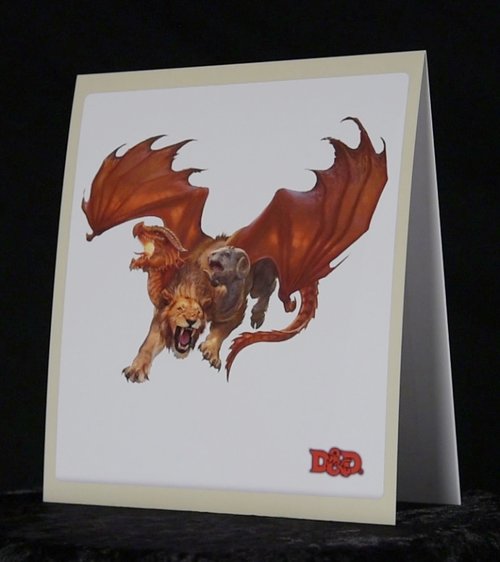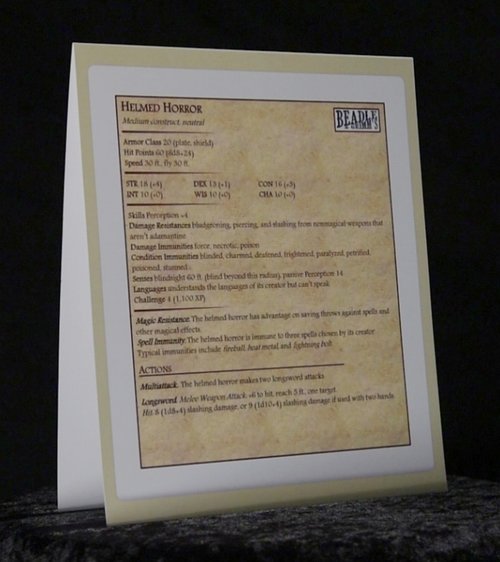Technically, all you need to play Dungeons & Dragons is a set of dice, a pencil, and a character sheet. Sure, it’s very helpful to have least one copy of the Players Handbook on the table, of course, but many optional tools are available for players and DMs that can make game play easier, or just more fun.
I’ve seen old and new players alike get excited about these tools when people use them in games at my shop, and I like using them myself. Since they are optional, some may seem extraneous if you are used to playing without them. It’s obviously is a matter of personal preference, but I like them a lot and I’m curious how you all feel about them.
Maps and Miniatures
Some people prefer the “theater of the mind” technique for everything, but I don’t know how you can effectively run a multi-character combat, or anything beyond a quick skirmish or a two-character fight, without a battle map. I tried once, and it was a mess. It doesn’t replace the need to verbally set the scene and narrate the action, but I am very much a visual learner, and I need to be able to see things in front of me. Seeing how the action plays out is especially important for most new players who are trying to learn game mechanics.
Maps can get incredibly elaborate (and very expensive!), and I could do a whole column on the cool accessories available, including terrain, mounts, combat tiers, and much more. However, I believe those things are genuinely optional. Old-school penciling things on a sheet of graph paper is all you absolutely need, but a good grid map that uses dry or wet erase markers works nicely with miniatures.
Speaking of miniatures, many players and DMs put a lot of effort into theirs, customizing and painting them with incredible detail. They can be a great way help create a little world, and a staggering array are commercially available now. But anything will work if you have a map to put it on. I’ve had players use all kinds of things in place of an actual mini, including a spare die, a coin, a wrapped Starburst candy, and a small ball of aluminum foil. This works for DMs too -- if you don’t have the right mini to represent a creature or object, you can substitute anything.
Initiative Indicators
Running combats goes more smoothly if everyone knows when their turn is coming up. Initiative tents are a popular solution. Fancy templates are available, but all you need is a strip of paper or an index card that you can fold in half and hang on top of your DM screen.
When I DM, I write the character’s name, the player’s name, and the character’s race and class on both sides so it’s visible to me and to the table. I like to put each character's passive perception on my side as well. Some DMs will add the character’s maximum hit points and other data; you can do whatever you think will help. Make tents for your monsters and NPCs too.
When initiative is rolled, you just rearrange the tents into that order and start the combat. This saves a lot of time because you don’t have to write names down or constantly remind everyone whose turn is now and who is up next.
I’ve seen other initiative indicator styles, including upright rods that you can clamp clothespins or other clips to, with the character’s name written on each clip. That takes up a little table space, but if that’s not an issue, I encourage you to get as crafty as you want to.
Spell Cards
Players have created their own spell cards for years, but now that they are commercially available, they are so popular we barely can keep them in stock at our shop. They are very helpful for newer players who want to try a spellcasting character, and an easy way for anyone to keep track of each spell without having to flip through the list in the PHB every time. As a DM, I love using them for NPCs who have a bunch of spells I’m not familiar with. Part of my prep routine for a game usually involves putting a one-off villain's spells into a nine-pocket card sheet for quick reference.
And good news, DMs: I hear monster cards are coming soon, so you can throw a surprise encounter at your players easily.
Inspiration Tokens
I love it when a DM rewards players with inspiration for particularly their inspired actions, funny lines, or great roleplay moments. You can always tell your player they have inspiration, which they can use according to your house rules (we can use it for advantage on a roll during that session, but I’ve heard of different methods). But it’s nice to give them a physical token to represent this boon. I’ve had DMs use campaign coins for this purpose. It’s such a good feeling to say something funny and receive a response in the form of a coin pitched in my direction. It also reminds me to actually use it, which I tend to forget if I just note it on my character sheet.
Bards can do this too! One of my players keeps extra dice on hand to lend when her bard gives another player inspiration. She literally hands them a d6, which they can add to a roll if necessary. Providing that tangible reminder is helpful, and players get more excited than I ever would have expected, especially new players. And that’s the whole point: finding ways to enhance everybody’s fun.
Do you use any tools of a similar nature that aren’t mentioned here? Because I’m always looking for ways to step up my game! Let me know in the comments.
contributed by Annie Bulloch
I’ve seen old and new players alike get excited about these tools when people use them in games at my shop, and I like using them myself. Since they are optional, some may seem extraneous if you are used to playing without them. It’s obviously is a matter of personal preference, but I like them a lot and I’m curious how you all feel about them.
Maps and Miniatures
Some people prefer the “theater of the mind” technique for everything, but I don’t know how you can effectively run a multi-character combat, or anything beyond a quick skirmish or a two-character fight, without a battle map. I tried once, and it was a mess. It doesn’t replace the need to verbally set the scene and narrate the action, but I am very much a visual learner, and I need to be able to see things in front of me. Seeing how the action plays out is especially important for most new players who are trying to learn game mechanics.
Maps can get incredibly elaborate (and very expensive!), and I could do a whole column on the cool accessories available, including terrain, mounts, combat tiers, and much more. However, I believe those things are genuinely optional. Old-school penciling things on a sheet of graph paper is all you absolutely need, but a good grid map that uses dry or wet erase markers works nicely with miniatures.
Speaking of miniatures, many players and DMs put a lot of effort into theirs, customizing and painting them with incredible detail. They can be a great way help create a little world, and a staggering array are commercially available now. But anything will work if you have a map to put it on. I’ve had players use all kinds of things in place of an actual mini, including a spare die, a coin, a wrapped Starburst candy, and a small ball of aluminum foil. This works for DMs too -- if you don’t have the right mini to represent a creature or object, you can substitute anything.
View attachment 98044
When the adventure calls for six giant badgers and you own zero badger minis, improvise!
When the adventure calls for six giant badgers and you own zero badger minis, improvise!
Initiative Indicators
Running combats goes more smoothly if everyone knows when their turn is coming up. Initiative tents are a popular solution. Fancy templates are available, but all you need is a strip of paper or an index card that you can fold in half and hang on top of your DM screen.
When I DM, I write the character’s name, the player’s name, and the character’s race and class on both sides so it’s visible to me and to the table. I like to put each character's passive perception on my side as well. Some DMs will add the character’s maximum hit points and other data; you can do whatever you think will help. Make tents for your monsters and NPCs too.
When initiative is rolled, you just rearrange the tents into that order and start the combat. This saves a lot of time because you don’t have to write names down or constantly remind everyone whose turn is now and who is up next.
I’ve seen other initiative indicator styles, including upright rods that you can clamp clothespins or other clips to, with the character’s name written on each clip. That takes up a little table space, but if that’s not an issue, I encourage you to get as crafty as you want to.
Spell Cards
Players have created their own spell cards for years, but now that they are commercially available, they are so popular we barely can keep them in stock at our shop. They are very helpful for newer players who want to try a spellcasting character, and an easy way for anyone to keep track of each spell without having to flip through the list in the PHB every time. As a DM, I love using them for NPCs who have a bunch of spells I’m not familiar with. Part of my prep routine for a game usually involves putting a one-off villain's spells into a nine-pocket card sheet for quick reference.
And good news, DMs: I hear monster cards are coming soon, so you can throw a surprise encounter at your players easily.
Inspiration Tokens
I love it when a DM rewards players with inspiration for particularly their inspired actions, funny lines, or great roleplay moments. You can always tell your player they have inspiration, which they can use according to your house rules (we can use it for advantage on a roll during that session, but I’ve heard of different methods). But it’s nice to give them a physical token to represent this boon. I’ve had DMs use campaign coins for this purpose. It’s such a good feeling to say something funny and receive a response in the form of a coin pitched in my direction. It also reminds me to actually use it, which I tend to forget if I just note it on my character sheet.
Bards can do this too! One of my players keeps extra dice on hand to lend when her bard gives another player inspiration. She literally hands them a d6, which they can add to a roll if necessary. Providing that tangible reminder is helpful, and players get more excited than I ever would have expected, especially new players. And that’s the whole point: finding ways to enhance everybody’s fun.
Do you use any tools of a similar nature that aren’t mentioned here? Because I’m always looking for ways to step up my game! Let me know in the comments.
contributed by Annie Bulloch





